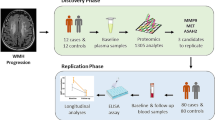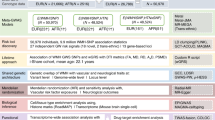Abstract
Compared with whites, blacks develop hypertension earlier in life, progress from prehypertension to hypertension at an accelerated rate, and exhibit greater hypertension-mediated organ damage (e.g., kidney disease, stroke). In this paper, we tested whether the longitudinal associations between elevated systolic blood pressure and disruption of brain white matter structural integrity differ as a function of race. A community sample of 100 middle-aged adults with prehypertension underwent diffusion imaging to quantify indirect metrics of white matter structural integrity, including fractional anisotropy. Blood pressure and diffusion imaging measurements were collected at baseline and at a 2-year follow-up. Regression analyses showed that higher systolic blood pressure at baseline was associated with a decrease in fractional anisotropy over 2 years in blacks only (β = −0.51 [95% CI = −0.85, −0.16], t = −2.93, p = 0.004, ΔR2 = 0.09). These findings suggest that blacks are more susceptible to the impact of systolic prehypertension on white matter structural integrity.
This is a preview of subscription content, access via your institution
Access options
Subscribe to this journal
Receive 12 digital issues and online access to articles
$119.00 per year
only $9.92 per issue
Buy this article
- Purchase on Springer Link
- Instant access to full article PDF
Prices may be subject to local taxes which are calculated during checkout


Similar content being viewed by others
References
Roger VL, Go AS, Lloyd-Jones DM, Benjamin EJ, Berry JD, Borden WB, et al. Heart disease and stroke statistics—2012 update: a report from the American Heart Association. Circulation. 2012;125:e2–e220.
Williams B, Mancia G, Spiering W, Agabiti Rosei E, Azizi M, Burnier M, et al. 2018 ESC/ESH Guidelines for the management of arterial hypertension. Eur Heart J. 2018;39:3021–104.
Faraco G, Iadecola C. Hypertension: a harbinger of stroke and dementia. Hypertension. 2013;62:810–7.
Pantoni L. Cerebral small vessel disease: from pathogenesis and clinical characteristics to therapeutic challenges. Lancet Neurol. 2010;9:689–701.
Scuteri A, Wang H. Pulse wave velocity as a marker of cognitive impairment in the elderly. J Alzheimers Dis. 2014;42(s4):S401–S10.
Pantoni L, Garcia JH, Gutierrez JA. Cerebral white matter is highly vulnerable to ischemia. Stroke. 1996;27:1641–7.
Aribisala BS, Morris Z, Eadie E, Thomas A, Gow A, Hernández MCV, et al. Blood pressure, internal carotid artery flow parameters, and age-related white matter hyperintensities. Hypertension. 2014;113:02735. HYPERTENSIONAHA
Launer LJ, Lewis CE, Schreiner PJ, Sidney S, Battapady H, Jacobs DR, et al. Vascular factors and multiple measures of early brain health: CARDIA brain MRI study. PLoS ONE. 2015;10:e0122138.
Haight T, Bryan RN, Erus G, Hsieh M-K, Davatzikos C, Nasrallah I, et al. White matter microstructure, white matter lesions, and hypertension: an examination of early surrogate markers of vascular-related brain change in midlife. NeuroImage: Clin. 2018;18:753–61.
Allen B, Muldoon MF, Gianaros PJ, Jennings JR. Higher blood pressure partially links greater adiposity to reduced brain white matter integrity. Am J Hypertens. 2016;29:1029–37.
Maillard P, Seshadri S, Beiser A, Himali JJ, Au R, Fletcher E, et al. Effects of systolic blood pressure on white-matter integrity in young adults in the Framingham Heart Study: a cross-sectional study. Lancet Neurol. 2012;11:1039–47.
Song S-K, Sun S-W, Ramsbottom MJ, Chang C, Russell J, Cross AH. Dysmyelination revealed through MRI as increased radial (but unchanged axial) diffusion of water. Neuroimage. 2002;17:1429–36.
Song S-K, Sun S-W, Ju W-K, Lin S-J, Cross AH, Neufeld AH. Diffusion tensor imaging detects and differentiates axon and myelin degeneration in mouse optic nerve after retinal ischemia. Neuroimage. 2003;20:1714–22.
Horsfield MA, Jones DK. Applications of diffusion‐weighted and diffusion tensor MRI to white matter diseases–a review. NMR Biomed. 2002;15:570–7.
Yusuf S, Reddy S, Ôunpuu S, Anand S. Global burden of cardiovascular diseases: part I: general considerations, the epidemiologic transition, risk factors, and impact of urbanization. Circulation. 2001;104:2746–53.
Selassie A, Wagner CS, Laken ML, Ferguson ML, Ferdinand KC, Egan BM. Progression is accelerated from prehypertension to hypertension in blacks. Hypertension. 2011;58:579–87.
Chaturvedi N, Bulpitt CJ, Leggetter S, Schiff R, Nihoyannopoulos P, Strain WD, et al. Ethnic differences in vascular stiffness and relations to hypertensive target organ damage. J Hypertens. 2004;22:1731–7.
Brickman AM, Schupf N, Manly JJ, Luchsinger JA, Andrews H, Tang MX, et al. Brain morphology in older African Americans, Caribbean Hispanics, and whites from northern Manhattan. Arch Neurol. 2008;65:1053–61.
Forouzanfar MH, Afshin A, Alexander LT, Anderson HR, Bhutta ZA, Biryukov S, et al. Global, regional, and national comparative risk assessment of 79 behavioural, environmental and occupational, and metabolic risks or clusters of risks, 1990–2015: a systematic analysis for the Global Burden of Disease Study 2015. Lancet. 2016;388:1659–724.
Gianaros PJ, Marsland AL, Sheu LK, Erickson KI, Verstynen TD. Inflammatory pathways link socioeconomic inequalities to white matter architecture. Cereb Cortex. 2012;23:2058–71.
Chobanian AV, Bakris GL, Black HR, Cushman WC, Green LA, Izzo JL,Jr et al. The seventh report of the joint national committee on prevention, detection, evaluation, and treatment of high blood pressure: the JNC 7 report. JAMA. 2003;289:2560–71.
Pickering TG, Hall JE, Appel LJ, Falkner BE, Graves J, Hill MN, et al. Recommendations for blood pressure measurement in humans and experimental animals: part 1: blood pressure measurement in humans: a statement for professionals from the Subcommittee of Professional and Public Education of the American Heart Association Council on High Blood Pressure Research. Circulation. 2005;111:697–716.
Smith SM. Fast robust automated brain extraction. Hum Brain Mapp. 2002;17:143–55.
Smith SM, Jenkinson M, Johansen-Berg H, Rueckert D, Nichols TE, Mackay CE, et al. Tract-based spatial statistics: voxelwise analysis of multi-subject diffusion data. Neuroimage. 2006;31:1487–505.
Hayes AF. Introduction to mediation, moderation, and conditional process analysis: a regression-based approach: Guilford Publications; New York, NY, 2017.
Aickin M. Dealing with change: using the conditional change model for clinical research. Prem J. 2009;13:80.
Johnson PO, Neyman J. Tests of certain linear hypotheses and their application to some educational problems. Statistical research memoirs. 1936;1:57–93.
Preacher KJ, Curran PJ, Bauer DJ. Computational tools for probing interactions in multiple linear regression, multilevel modeling, and latent curve analysis. J Educ Behav Stat. 2006;31:437–48.
Seo Y, Kim G-T, Choi JW. Early detection of neonatal hypoxic–ischemic white matter injury: an MR diffusion tensor imaging study. Neuroreport. 2017;28:845.
Wang S, Wu EX, Tam CN, Lau H-F, Cheung P-T, Khong P-L. Characterization of white matter injury in a hypoxic-ischemic neonatal rat model by diffusion tensor MRI. Stroke. 2008;39:2348–53.
Iadecola C. The pathobiology of vascular dementia. Neuron. 2013;80:844–66.
Rosenberg GA. Inflammation and white matter damage in vascular cognitive impairment. Stroke. 2009;40(3 suppl 1):S20–S3.
Power MC, Tingle JV, Reid RI, Huang J, Sharrett AR, Coresh J, et al. Midlife and late‐life vascular risk factors and white matter microstructural integrity: the atherosclerosis risk in communities neurocognitive study. J Am Heart Assoc. 2017;6:e005608.
Rosano C, Abebe KZ, Aizenstein HJ, Boudreau R, Jennings JR, Venkatraman V, et al. Longitudinal systolic blood pressure characteristics and integrity of white matter tracts in a cohort of very old black and white adults. Am J Hypertens. 2014;28:326–34.
Suzuki H, Gao H, Bai W, Evangelou E, Glocker B, O’Regan DP, et al. Abnormal brain white matter microstructure is associated with both pre-hypertension and hypertension. PLoS ONE. 2017;12:e0187600.
Morgello S, Murray J, Van Der Elst S, Byrd D. HCV, but not HIV, is a risk factor for cerebral small vessel disease. Neurol-Neuroimmunol Neuroinflamm. 2014;1:e27.
Rostand SG, Cross SK, Kirk KA, Lee JY, Kuhlmann A, Amann K. Racial differences in renal arteriolar structure in children with minimal change nephropathy. Kidney Int. 2005;68:1154–60.
Acknowledgements
This study was supported by grants from the (National Heart Lung and Blood Institute (HL101959, HL089850, and HL007560)).
Author information
Authors and Affiliations
Corresponding author
Ethics declarations
Conflict of interest
The authors declare that they have no conflict of interest.
Additional information
Publisher’s note: Springer Nature remains neutral with regard to jurisdictional claims in published maps and institutional affiliations.
Supplementary information
Rights and permissions
About this article
Cite this article
Allen, B., Muldoon, M.F., Gianaros, P.J. et al. The prospective relationship between prehypertension, race, and whole-brain white matter microstructure. J Hum Hypertens 34, 82–89 (2020). https://doi.org/10.1038/s41371-019-0184-0
Received:
Revised:
Accepted:
Published:
Issue Date:
DOI: https://doi.org/10.1038/s41371-019-0184-0



